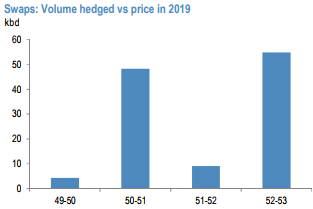US West Texas Intermediate crude goes up 66 cents at $57.80 a barrel while articulating ahead of EIA’s inventory check today.
The largest UK oil pipeline system, the Forties pipeline, was shut down on Monday to undergo emergency repairs. This disrupted over 400 kb/d of flows planned for December.
Front-month ICE Brent crude prices surged from $63 late Friday/early Monday to nearly $66 early Tuesday, before falling back to $64. While the Forties shutdown has provided a price floor, flat price gains quickly evaporated in a global market that is still oversupplied and with output rising in the United States.
As we enter 2018, this equation should change as producers use swaps for the rest of the year. In terms of pricing, there were more volumes hedged between $49-52/bbl WTI, Exhibit 8, followed by slightly lower volumes hedged between $52-55/bbl. Limited volumes were hedged around $55-57/bbl levels.
This clearly is interesting to note as producers were very comfortable around the lower 50’s to hedge. For 2019, producers hedged mostly in the lower 50’s range once again (refer above diagram).
Additionally given the volumes hedged is significantly lower in 2019, producers would rather wait and watch and layer in when oil prices get supported intermittently. There is also a trend of smaller producers hedging at slightly lower price levels than the large caps for both 2018 and 2019 but that is still a marginal difference.
However despite higher hedges in place which might pose risk to oil markets as US producers are typically expected to add more oil on the back of hedged volumes, can they and will they add the extra barrels significantly on top of the hedged barrels which are not typically hedged? We take a look at both upside and downside risks to US upstream production.



 ETHUSD Defies ETF Outflows: Holds Above $3000, Bulls Eye $3200 Breakout
ETHUSD Defies ETF Outflows: Holds Above $3000, Bulls Eye $3200 Breakout  Mexico's Undervalued Equity Market Offers Long-Term Investment Potential
Mexico's Undervalued Equity Market Offers Long-Term Investment Potential  JPMorgan’s Top Large-Cap Pharma Stocks to Watch in 2026
JPMorgan’s Top Large-Cap Pharma Stocks to Watch in 2026  Fed May Resume Rate Hikes: BofA Analysts Outline Key Scenarios
Fed May Resume Rate Hikes: BofA Analysts Outline Key Scenarios  Geopolitical Shocks That Could Reshape Financial Markets in 2025
Geopolitical Shocks That Could Reshape Financial Markets in 2025  UBS Predicts Potential Fed Rate Cut Amid Strong US Economic Data
UBS Predicts Potential Fed Rate Cut Amid Strong US Economic Data  Robinhood Expands Sports Event Contracts With Player Performance Wagers
Robinhood Expands Sports Event Contracts With Player Performance Wagers  Indonesia Surprises Markets with Interest Rate Cut Amid Currency Pressure
Indonesia Surprises Markets with Interest Rate Cut Amid Currency Pressure  Global Demand for Yuan Loans and Bonds Surges as China Pushes Currency Internationalization
Global Demand for Yuan Loans and Bonds Surges as China Pushes Currency Internationalization  Goldman Predicts 50% Odds of 10% U.S. Tariff on Copper by Q1 Close
Goldman Predicts 50% Odds of 10% U.S. Tariff on Copper by Q1 Close 































